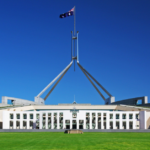Nonviolent Civil Disobedience: The Gandhian Influence on Climate Activists

The Intergovernmental Panel on Climate Change reported in October last year that at the time, humans had 12 years to curb global greenhouse gas emissions to prevent the climate and ecological catastrophe the Earth is currently plummeting towards.
This grave scientific forecast has sparked climate activists into action the world over. Locally, members of the climate movement Extinction Rebellion (XR) descended upon the Sydney offices of multinational GHD on Tuesday to protest its involvement with the Adani Carmichael coal mine.
XR declared open rebellion in London on 31 October last year. And the movement has been very clear that the way it plans to bring about its aim of halting the climate emergency is via acts of nonviolent civil disobedience.
This form of direct action has long been recognised amongst protest movements as the most effective way to bring about societal shift. And this method of nonviolent protest was born out of the doctrine of satyagraha espoused by Indian independence leader and lawyer Mahatma Gandhi.
And while the heralding of Gandhi as a saint has become problematic over recent years, there’s no denying that his doctrine of satyagraha/nonviolent civil disobedience has gone on to shape civil society movements globally and may hold the key to averting climate collapse.
The ethics of nonviolence
“Violence cannot achieve half of what nonviolence and satyagraha can achieve,” philosopher and scholar Dr Purushottama Bilimoria made clear. Gandhi “moved the passive ideals of non-resistance, or just passive resistance, to active engaged resistance and nonviolent political strategy”.
Dr Bilimoria is a visiting professor at the University of California Berkeley campus, where he teaches a legal studies course on the globalisation of the nonviolence movement in the struggle against oppression and Gandhi’s influence upon it.
The doctor notes that the thought of Russian novelist Leo Tolstoy and American philosopher Henry Thoreau helped to influence satyagraha, which Gandhi stressed was not a method of the weak, but “is a weapon of the strong” that “always insists upon the truth”.
“The Gandhian method of addressing climate change began in the West with Arne Naess, the Common Green movement in the UK, and the Chipko Movement in India,” Dr Bilimoria told Sydney Criminal Lawyers.
Satyagraha in practice
The nonviolent civil disobedience that Gandhi advocated involves people breaking the law to draw attention to injustice. And this civil lawbreaking involves individuals inviting the punishment that results from committing an offence, rather than avoiding it, in the way that criminals do.
Gandhi began to develop the doctrine of satyagraha whilst he was living in South Africa, so as to bring about societal change for South Asians living in that country. And after he returned to India in 1915, he began to utilise nonviolent civil disobedience in order to rid his country of British rule.
The quintessential example of Gandhi taking nonviolent civil disobedience action is the Salt March in 1930. This saw the lawyer march 240 miles to the Arabian Sea, so as to source his own salt, which was in direct contravention of British law, as it prohibited Indian people from doing so.
By the time he hit the coast, Gandhi was being followed by thousands of locals. The protest sparked civil disobedience across the subcontinent, with 60,000 people being arrested. And the satyagraha succeeded in drawing global attention to the oppressive British rule in India.
Gandhi’s final satyagraha was the 1942 Quit India campaign. It focused on “an orderly British withdrawal” and had a “do or die” emphasis for those involved. While none of these actions directly led to the British leaving India, their combined impact greatly influenced their departure.
Ending oppression
“The destruction of our planet is the result of violence,” said Extinction Rebellion Bondi Beach organiser Larissa Payne. “Ecocide and ethnocide are by-products of the quest for economic dominance and infinite growth, made toxic by the neoliberal model.”
And according to Ms Payne, nonviolent civil disobedience has proven effective in numerous scenarios. “Martin Luther King Jr applied nonviolent civil disobedience to the American civil rights movement”, while “Nelson Mandela utilised it to dismantle apartheid”.
“More recently, Mohamed Bouazizi’s self–immolation to protest Tunisian authoritarianism saw Ben Ali flee and the Arab Spring begin,” she continued, adding that “when we partake in nonviolent civil disobedience, we create a quandary, opening a space that didn’t exist previously”.
The long-time activist outlined that “numerous academic studies” have shown that “nonviolent actions are most effective in creating change”. And she pointed to US political scientist Dr Erica Chenoweth, who posits that nonviolent resistance can often end authoritarianism.
“We act on behalf of life”
“Extinction Rebellion is for everyone,” Ms Payne emphasised. “And I don’t just mean those within the movement, but the broader community, even adversaries for whom we may need to share a table.”
“Nonviolent civil disobedience is called for because we must disrupt the status quo,” she went on. “Business as usual has created a hall pass for planetary destruction and the potential end of civilization.” And lawful protests aren’t going to cut it anymore.
The XR Declaration of Rebellion states that humanity is in its “darkest hour”, as the Earth is facing its sixth mass extinction. And it further asserts that government and the law are now failing to provide any assurances or protection against the pending climate crisis.
Ms Payne painted a grim picture of why nonviolent civil disobedience is needed: increasing greenhouse emissions, heating oceans, mass deforestation in the Amazon, rising sea levels in Tuvalu and Kiribati, and having to truck in water to drought-stricken towns in western NSW.
“When you’re up against the obscene wealth of an entity like the fossil fuel industry, leverage is critical,” Ms Payne concluded. “We don’t have the economic clout of fossil capital, but we have our voices and bodies.”







